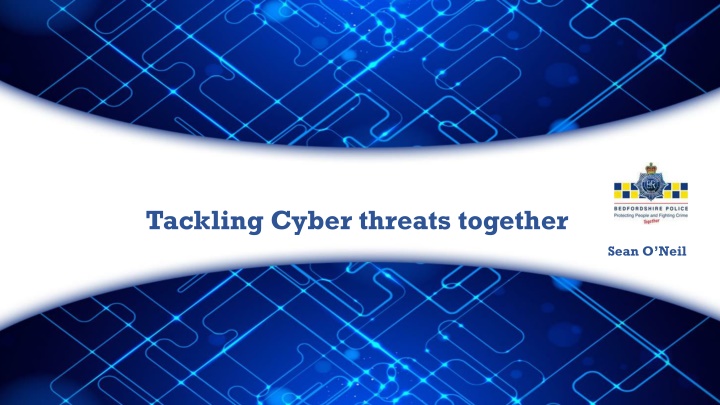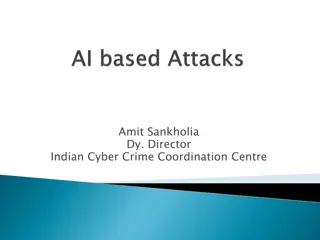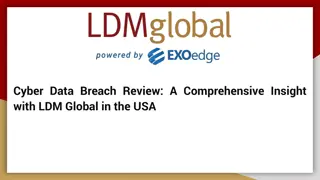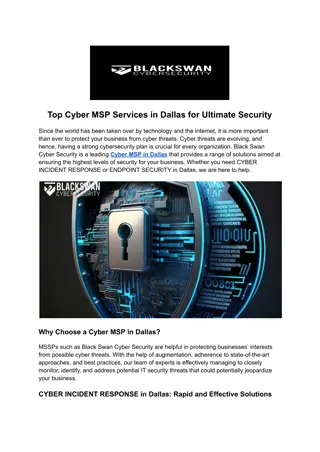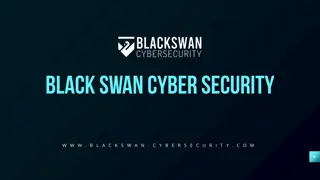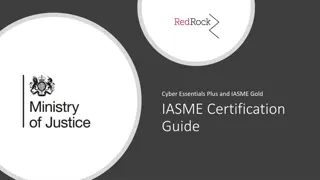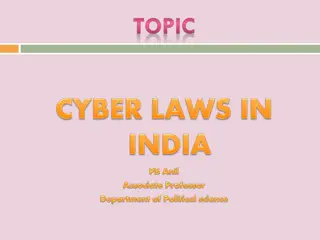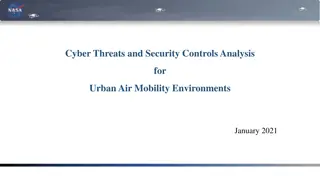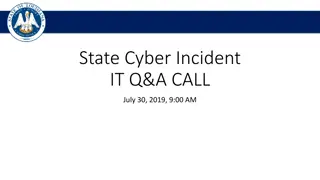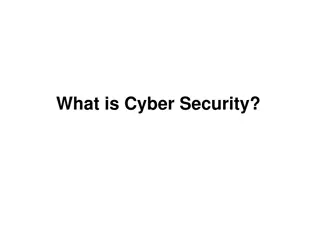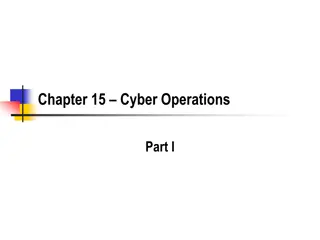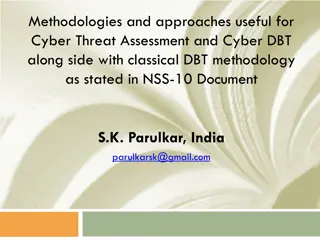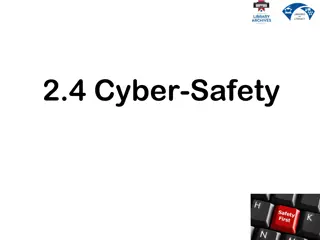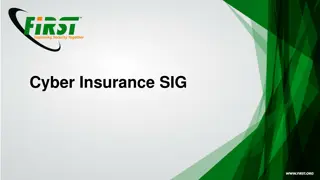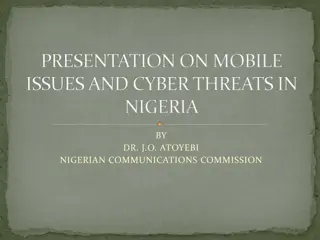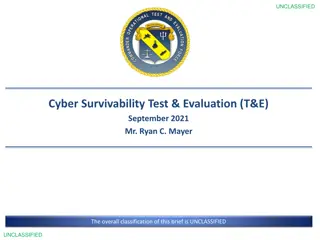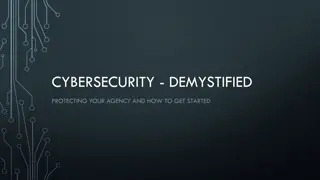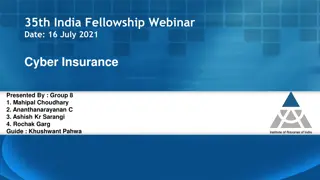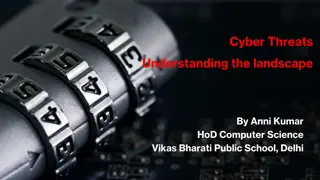Tackling Cyber threats together
In this insightful book, Sean O'Neil provides valuable strategies for addressing cyber threats collectively. It delves into the importance of collaboration and proactive measures, offering a comprehensive approach to cybersecurity. The author's expertise shines through as he navigates the complexities of modern-day digital risks, empowering readers to enhance their security practices. "Tackling Cyber Threats Together" is a must-read for individuals and organizations looking to strengthen their defenses in an increasingly digital world.
Download Presentation

Please find below an Image/Link to download the presentation.
The content on the website is provided AS IS for your information and personal use only. It may not be sold, licensed, or shared on other websites without obtaining consent from the author.If you encounter any issues during the download, it is possible that the publisher has removed the file from their server.
You are allowed to download the files provided on this website for personal or commercial use, subject to the condition that they are used lawfully. All files are the property of their respective owners.
The content on the website is provided AS IS for your information and personal use only. It may not be sold, licensed, or shared on other websites without obtaining consent from the author.
E N D
Presentation Transcript
Tackling Cyber threats together Sean O Neil
Cyber security advisor Sean O Neil; Over 30 years experience in the Police Previous role was Detective Chief Inspector with regional major crime unit. Senior Investigating Officer (SIO) for Murder, kidnap, extortion and product contamination; and wider reputational incidents such as Slavery, Large scale frauds and internal matters. He carried out investigations in several other countries and also prosecuted overseas; by assisting foreign Courts and Governmental bodies. Red centre commander (Kidnap/tiger kidnap negotiations) Covered Bedfordshire, Hertfordshire, & Cambridgeshire. 3 years in private industry, ecommerce company investigation serious and organised crime on company. On-line frauds by vendors/customers, serious thefts by employees. Organised on-line attacks. Physical security auditor.
Areas of discussion (in brief) What is Cyber Crime? Recent intelligence and current threats Advice on how to protect yourselves Ways you may choose to protect yourselves, with CBR, CisP, POC.
What is Cyber Crime? The adopted definition of Cyber Crime is: Cyber Dependent Crimes, where a digital system is the target as well as the means of attack. These include attacks on computer systems to disrupt IT infrastructure, and stealing data over a network using malware (the purpose of the data theft is usually to commit further crime). Cyber Enabled Crimes. Existing crimes that have been transformed in scale or form by their use of the Internet. The growth of the Internet has allowed these crimes to be carried out on an industrial scale. The use of the Internet to facilitate drug dealing, people smuggling and many other 'traditional' crime types.
Which of these is a cyber threat? http://www.hardwaresecrets.com/wp-content/uploads/email-logo.jpg http://2.bp.blogspot.com/-v8i0u-I9I4o/UPmYyfJV4xI/AAAAAAAAANo/abojB3fD-xo/s1600/usb-stick.jpg http://www.v3.co.uk/IMG/148/280148/nest-thermostat-540x334.jpeg?1434607528 http://smallbusiness.chron.com/DM-Resize/photos.demandstudios.com/getty/article/189/149/76800072.jpg?w=650h=406keep_ratio=1webp=1 http://www.twinfinite.net/wp-content/uploads/2015/05/xbox-one.jpg http://reilly.nd.edu/assets/142510/original/rfidimplant.jpg POTENTIALLY ALL OF THEM!
But what are some of the biggest threats? Insider Threat (theft/fraud/data breach) Malware by phishing attacks Data Breach DDoS Social Engineering leading to scams Theft/fraud by Customers or vendors. Ultimately it depends on the business, how it is set up, the infrastructure and the policies and procedures, and protect mechanisms in place. Does your BCP include no use of IT or loss of data!
And now for some good news!! GCHQ reported in 2014 that in terms of Cyber Crime 80% is easily preventable http://mareesdoctorate.files.wordpress.com/2013/07/tick.jpg
What do you think? The 2015 Information Breaches Survey reported that 90% of large organisations and 74% of small businesses had security breaches. 1) What is the cost of an attack on a SME? Repair, return to normality and compensation. What about loss of trade/reputation! (Up from 65k - 115k in 2014) 75k - 311k 2) What is cost on a large businesses? (Up from 600k - 1.5m in 2014) Could your company cope with this cost. The cost of security is always too much until it is not enough! Protection is cheaper then recovery 1.46m - 3.14m
Intelligence & current threats Advice on how to protect yourselves
Insider threat Theft/fraud by employee Data breach (increased threat when leaving take to new employment, sell). Tactical advice NDA (visitors & employees) ICT group permissions account closure process.
Social engineering by Dodgey Sean (outsider threat) Visit your house (on street view & in person). Check letterboxes and enter your garden! Look in waste bins to steal mail, specifically banking documentation and personal correspondence. What security do you have (CCTV!) Scan your Wi-Fi View uploaded photo s. all about you & family fb, LinkedIn, Twitter, Visit place of work. Penetration test (physical security/reception visitor policy. Research on internet. (what does Google or company website say about you) Dark web (underground websites; purchase CC, bank details, accounts & passwords).
Mandate fraud / CEO fraud/ payment diversion Fraudsters targeting senior Executives Fraudsters targeting senior Executives. . Typically starts with a spoof email being sent from a fraudster to a member of staff in a company s finance department, but may be sent to the procurement or other account holder. The member of staff will be told by the fraudster who is purporting to be a company director or CEO/CFO, that they need to quickly transfer to a certain bank account for a specific reason. The member of staff will do as their boss has instructed, only to find that they have sent money to a fraudster s bank account. There have been many other versions that include requesting payment details changed on existing vendors accounts. The fraudster will normally redistribute this money into other mule accounts and then close down the bank account to make it untraceable. Very little of the funds are ever recovered. Tactical advice: Check mailbox regularly, assess where mail is deposited for vulnerabilities. Consider security measures. Dispose of confidential mail securely i.e. shredding. Place bins in locked location, consider CCTV coverage. To reduce social engineering consider what information you place on social networking sites regarding you, your home, and place of employment. Put in place company procedures to challenge/double check any attempt to change any payment details.
Online extortion demand affecting UK businesses Ransome ware threats: extortion demands from a group calling themselves 'Lizard Squad'. Method of Attack: The group have sent emails demanding payment of 5 Bitcoins, to be paid by a certain time and date. The email states that this demand will increase by 5 Bitcoins for each day that it goes unpaid. If their demand is not met, they have threatened to launch a Denial of Service attack (DDoS) against the businesses' websites and networks, taking them offline until payment is made. The demand states that once their actions have started, they cannot be undone.
Tactical advice : Report to Law Enforcement (LE); via AF, 101, + cyberprotect@bedfordshire.pnn.police.uk Do not pay the demand. You will be highlighted as a payer and get more ransoms. Retain the original emails (with headers), Maintain a timeline of the attack, recording all times, type and content of the contact. Highlight on CisP. If you are experiencing a DDoS as above. Call your Internet Service Provider (ISP) (or hosting provider/Web server) inform under attack and ask for help. Keep a timeline of events and save server logs, web logs, email logs, any packet capture, network graphs, reports etc. Consider the likelihood and risks to your organisation of a DDoS attack, and put appropriate threat reduction/mitigation measures in place, ie second server/gateway. speak to a DDoS prevention specialist. you should have the hosting facilities in place to handle large, unexpected volumes of website hits.
Malware attacks Malware, which is short for malicious software, refers to any software that s designed to disrupt or damage a system, and cause harm to the user (you). Viruses, trojans and worms are a few of the most common types of malware. Banking malware is specifically designed to intercept and steal a user's financial details. There are many ways malware can infect a device, whether it be a link to a malicious website in an unsolicited email, or installing an app from an unofficial app store. Stats: 1 - 390,000 - The number of new malicious software programs detected every single day - (https://www.av-test.org/en/statistics/malware/) 2 - 1,966,324 - Attempted malware infections that aimed to steal money via online access to bank accounts. (https://securelist.com/analysis/kaspersky-security- bulletin/73038/kaspersky-security-bulletin-2015-overall-statistics-for-2015/) 3 - 20m - The estimated financial loss to the UK from just one piece of banking malware (Dridex) - http://www.nationalcrimeagency.gov.uk/news/723-uk-internet- users-potential-victims-of-serious-cyber-attack
Tactical advice: Don t click on links you receive in unsolicited emails or SMS messages. The links may lead to malicious websites, and any attachments could be infected with malware. Only install apps from official app stores, such as Google s Play Store, or Apple s App Store. When logging in to your online banking account, be extremely cautious if you re asked for details such as the 3 digit (CVV) number on the back of your card, the long number on the front of the card, your card s expiry date, or the 4 digit PIN for your card. If the online banking login page you re on does ask for these details, then don t login until you ve called your bank to verify that you're logging in to a genuine web page. Your bank will never ask you to transfer money out of your account and into another. If you receive messages, browser pop ups or calls asking you to do this, then don t respond to them. Call your bank immediately.
Account take overs /compromised accounts Compromised accounts caused by poor PW protocol in some businesses, have led changes being made to credit card details [stolen/obtained on dark web added], and delivery addresses changed Purchases are then made on customer accounts without their knowledge; leading to very high loss due to credit card charge backs. Plus reduced customer confidence. Causes high loss to the company and need for increased fraud management Tactical advice: Increase PW protocol. Contact customer if unusual orders are placed, double check new delivery addresses. Report incidents to LE.
Ways you may choose to protect yourselves: CBR - Free service to all local businesses, organisations, charities, vulnerable people Offering a review of current practices Suggesting improvements to ICT/physical security Leading to greater ability to reach cyber essentials accreditation - Minimum standard suggested for government contracts in the future. CisP POC
Lets Finish on Three Simple Pieces of Advice Screen clippings taken from www.cyberstreetwise.com
POC: Who do I contact and how? Action Fraud 0300 123 2040 Urgent Incidents 999 or 101 (local Force response) Non urgent incidents 101 / Action Fraud Non urgent in office hours Local Force Cyber Crime Unit cyberprotect@bedfordshire.pnn.police.uk Regional Unit will pick up incidents/cases through a tasking process that local Forces initiate. To prevent loss of data, contact local force or security advisor. Action Fraud will disseminate cases and investigations across to Forces following research and analysis of information provided
Thank you! Sean O Neil Cyber Security Advisor (2219) Bedfordshire Police Headquarters, Woburn Road, Kempston, Bedfordshire, MK43 9AX (+44) 7720204358 sean.oneil@bedfordshire.pnn.police.uk cyberprotect@bedfordshire.pnn.police.uk
